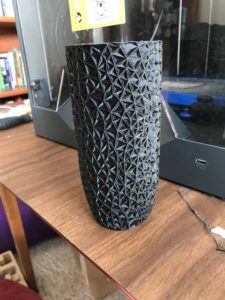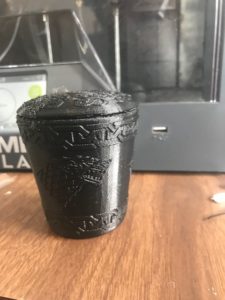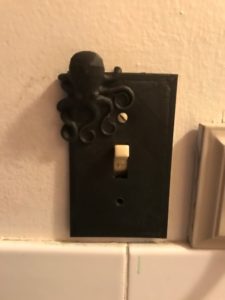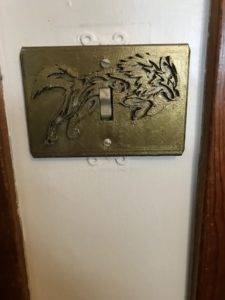 A little over a year ago, I had the opportunity to review the Dremel Idea Builder 3D40 3D printer, and so unpacking the review unit of the Dremel DigiLab 3D45 was kind of like greeting an old friend – who had undergone some noticeable changes. The DigiLab 3D45 was introduced last summer and, like the Idea Builder, it was made for education – but this particular model is made more for high school and college classes. It’s not any more complicated to use than the Idea Builder, but it has more options and is better suited to more complex projects.
A little over a year ago, I had the opportunity to review the Dremel Idea Builder 3D40 3D printer, and so unpacking the review unit of the Dremel DigiLab 3D45 was kind of like greeting an old friend – who had undergone some noticeable changes. The DigiLab 3D45 was introduced last summer and, like the Idea Builder, it was made for education – but this particular model is made more for high school and college classes. It’s not any more complicated to use than the Idea Builder, but it has more options and is better suited to more complex projects.
While the Idea Builder only prints with PLA, the DigiLab can handle PLA, ABS and Nylon, each of which was included with the 3D printer – lots of each, actually. I had six spools of filament in total, more than I knew what to do with – but I was certainly going to do my best to get the most out of them. I set up the 3D printer, which was wonderfully easy – literally plug and print.
Rather than using the included slicing software, I decided to rely solely on the easy-to-use 3DPrinterOS print cloud, accessible from Dremel’s website, which was a simple and fast slicer.
I was excited to have multiple kinds of filament to experiment with – especially nylon, which I had never 3D printed with before. I found Dremel’s black nylon filament to be very pleasant to print with, delivering finished pieces with an almost velvety sheen.
I went for pieces with a high level of detail, such as this vase and this House Stark dice cup (which I found in this handy 3D printable Game of Thrones things collection) and they printed beautifully.
The ECO-ABS, which is a heavily modified PLA without the harmful VOCs, and PLA printed just fine, too. One of the ECO-ABS prints warped slightly later on, but that was likely more due to a struggle with removing a raft, as well as the fact that I placed it in the most humid room in the house, the bathroom. I couldn’t think of anywhere better to put this octopus light switch plate, however.
I can’t emphasize enough the difference that a heated build plate makes, no matter what kind of material you’re working with.
When I worked with the Idea Builder, I had a nightmare getting the PLA to stick to the build platform, even with the provided painter’s tape and a layer of glue – it was only when I started slathering thick layers of glue directly on the platform that I could get my prints to reliably adhere to the surface. With the DigiLab’s heated build plate, I’ve had no trouble at all. Printing feels luxuriously easy. I have been using the provided glue sticks, but compared to those same glue sticks on an un-heated platform, there’s still a world of difference.
 The DigiLab is a nicely quiet 3D printer, too – I’ve had it running in my office and been barely able to hear it from the next room.
The DigiLab is a nicely quiet 3D printer, too – I’ve had it running in my office and been barely able to hear it from the next room.
The touchscreen is easy to use, although I noticed one weird thing – the 3D printer doesn’t always like to print more than one thing in a row. I would remove one print, get another one set, and hit “build” on the touchscreen – and nothing would happen. This happened more than once, and I solved it by using the universal solution – turning the printer off and turning it back on again. Once I did that, everything proceeded swimmingly. Not a major complaint, but if you run into the same problem, that’s one way to fix it.
Another issue was the filament detection system, which didn’t always detect the correct filament. A few times it triumphantly proclaimed “PLA!” after I had removed the PLA and put in nylon instead, and I had to run through the “Change Filament” cycle on the touchscreen again before the printer registered that there was a new material there. (Note: I’ve since learned that this issue has been remedied with a firmware update.)
Overall, I liked working with this 3D printer. Dremel describes it as “frustration-free 3D printing” and for the most part that was so, other than a few little glitches.
It’s compact but has a good build area for its size. It’s easy to use, fast to set up, and it produces quality prints. I would call it the grown-up version of the Idea Builder – simple and quiet enough for an educational setting, but with more options. I’d recommend it to a school or an individual who wants decent prints but doesn’t want to be bothered by having to learn anything too complicated.
The DigiLab 3D45 3D printer is available from Dremel at $1,799.
Discuss this and other 3D printing topics at 3DPrintBoard.com or share your thoughts below.
[All photos: Clare Scott]
Subscribe to Our Email Newsletter
Stay up-to-date on all the latest news from the 3D printing industry and receive information and offers from third party vendors.
You May Also Like
3D Printing News Unpeeled: A $3000 SLS System, Construction Subsidies and Parameters
The Housing Affordability Crisis is one of Canadian President Trudeau’s biggest issues. Now the government has made subsidies available, including scaling new technologies, 3D printed housing and libraries of reapproved...
“Bundled Light” Enables High Quality Plastic 3D Printing from LEAM
Naturally, we expect current 3D printing methods to continuously improve, but it continues to do so in the most surprising ways. The latest development comes from LEAM, a startup spun...
Each to Their Own: Exploring Creality’s Latest Ender Trio as the Company Strengthens Its Commitment to 3D Printing Advocacy
Creality has reaffirmed its commitment to promoting 3D printing. The launch of the Ender-3 V3 SE, Ender-3 V3 KE, and Ender-3 V3 showcases the company’s dedication to catering to diverse...
3D Printing News Briefs, March 23, 2024: AM in the US Coast Guard, Navy, & More
In today’s 3D Printing News Briefs, we’re discussing the use of 3D printing in various branches of the military, including the U.S. Coast Guard, the U.S. Navy, and the German...



































